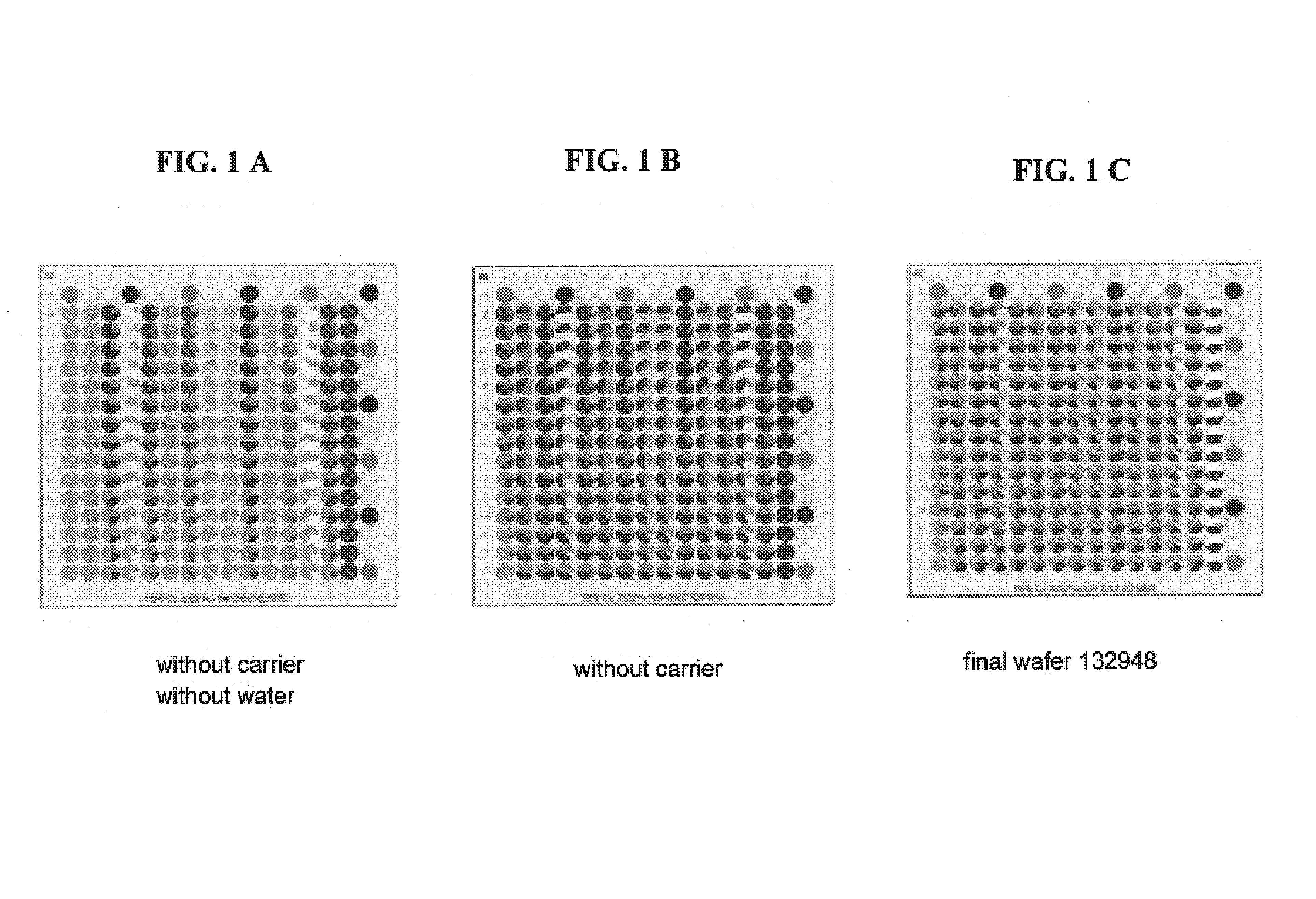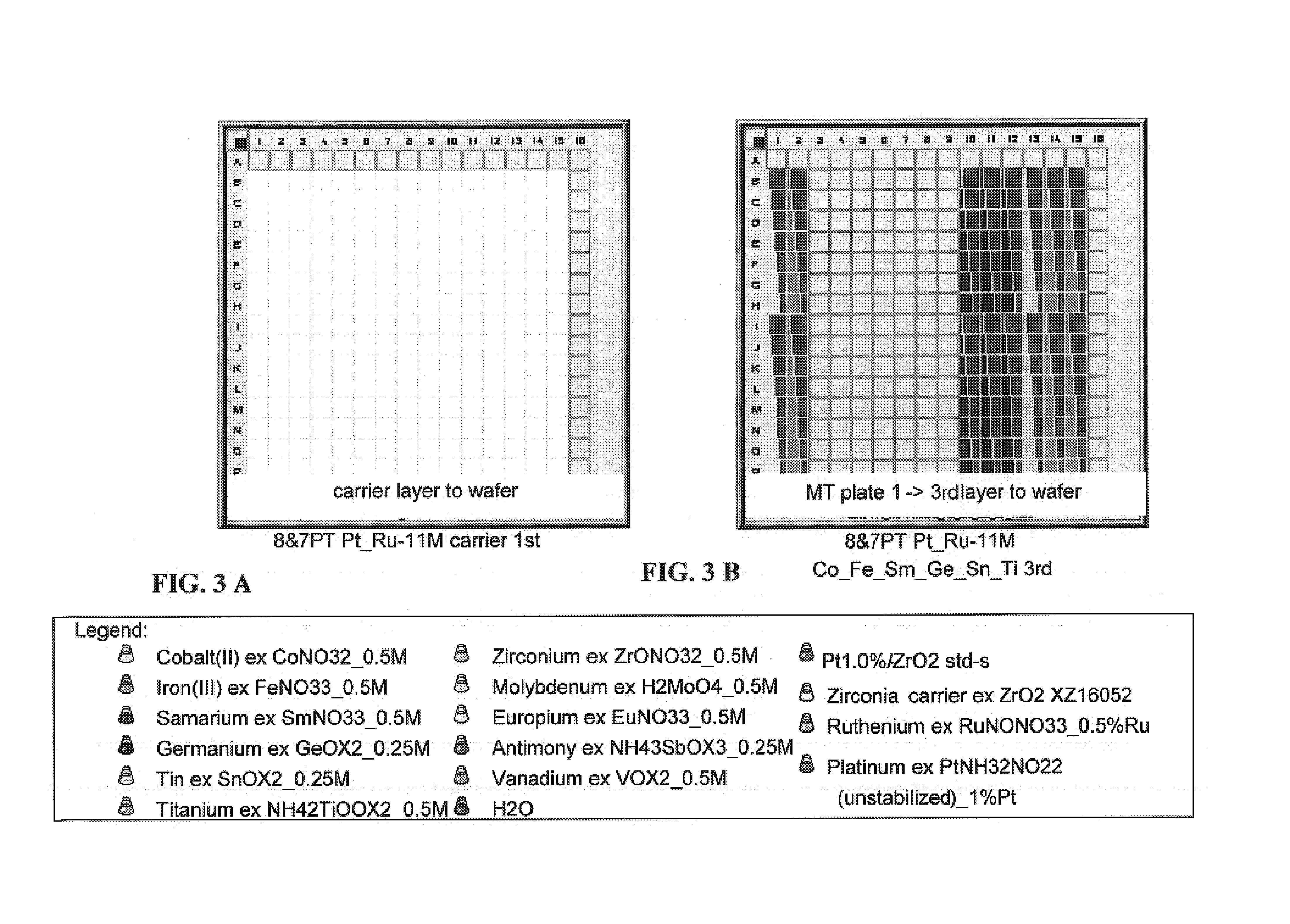Platinum-free ruthenium-cobalt catalyst formulations for hydrogen generation
a technology of ruthenium cobalt and catalyst formulation, which is applied in the field of methods and catalysts, can solve the problems of insufficient activity of existing catalyst formulations at low temperatures, inability to reach or even closely approach, and inability to achieve or even closely approach the effect of existing catalyst formulations, etc., and achieves high the effect of increasing the lts and mts activity of supported or unsupported catalysts
- Summary
- Abstract
- Description
- Claims
- Application Information
AI Technical Summary
Benefits of technology
Problems solved by technology
Method used
Image
Examples
example 1
[0190]A 4″ quartz wafer was pre-coated with 14 columns of Engelhard Co-164 (bulk Co commercial catalyst) and ZrO2 (Norton XZ16052) as reference carrier by slurry dispensing as a mnaster batch in volumes of 3μL (both 1.5 g / 4 mL, EG / H2O / MeO 32.5:30:37.5) to a 15×15 square on the wafer. After the dispensing step the wafer was oven-dried at 70° C. for 14 minutes.
[0191]Six internal standards were synthesized by Cavro spotting 3 μL of Pt(NH3)2(NO2)2 (stabilized, 2.5% Pt) stock solution into the corresponding first row / last column positions. The Co-bulk carrier pre-coated wafer was impregnated with a ruthenium(III) nitrosyl nitrate (diluted in dilute nitric acid and containing 1.5% Ru) gradient from top to bottom by Cavro dispensing from the respective stock solution vial to a microtiter plate and diluting with distilled water followed by a one-to-one transfer of the microtiter plate pattern to the wafer. The Ru solution was dispensed in 2.5 μL dispense volume per well resulting in a 14×15...
example 2
[0195]A 4″ quartz wafer was precoated with ZrO2 carrier by repeated slurry dispensing of zirconia powder (Norton XZ16052 / MEI FZO923 / 01 70:30 mix) onto the wafer (1 g zirconia powder in 4 mL EG / H2O 50:50 mixture, 2 zirconia layers=2×3 μL=6 μL slurry dispensed in total). The zirconia carrier-precoated wafer was dried and then impregnated with gradients of the metals (Co, Ni, Cu, Fe and Ru). Advantageously, all metal precursor solutions (metal nitrates and Ru nitrosyl nitrate) are compatible and a single impregnation step suffices to deposit all the metals. The gradients were premixed in a microtiter plate by dilution of metal nitrate stock solutions with water. The diluted solutions are then transferred from the microtiter plate to the wafer by Cavro dispensing (3 μL dispense volume per well). The wafer was dried, calcined in air at 500° C. for 1 hour and then reduced in 5% H2 / Ar at 380° C. for 3 hours. See FIGS. 2A and 2B.
[0196]The reduced wafer was then screened by SMS for WGS activ...
example 3
[0198]A 4″ quartz wafer was precoated with zirconia carrier by repeated slurry dispensing zirconia powder (Norton XZ16052) onto the wafer. The slurry was composed of 1.5 g zirconia powder in 4 mL of a MEO / EG / H2O 40:30:30 mixture. A total of 3 μL of slurry was deposited on each spot.
[0199]The zirconia carrier precoated wafer was impregnated with separate concentration gradients of Co, Fe, Sm, Ge, Sn and Ti by Cavro dispensing from metal stock solution vials to a microtiter plate (five, four, one, two, one, two columns, respectively of each metal in 7-point (“7P”) and 8-point (“8P”) concentration gradients) followed by transferring replicas of the four 7P and 8P columns onto the wafer (2.5 μL dispense volume per well). The wafer was dried at 70° C. for 10 minutes.
[0200]The wafer was then impregnated with Fe, Zr, Ti, Mo, Eu, Sn, Sb and V concentration gradients by Cavro dispensing 2.5 μL per well in 7-point and 8-point gradients. The metal columns were arranged in the following order b...
PUM
| Property | Measurement | Unit |
|---|---|---|
| temperature | aaaaa | aaaaa |
| pressure | aaaaa | aaaaa |
| pressure | aaaaa | aaaaa |
Abstract
Description
Claims
Application Information
 Login to View More
Login to View More - R&D
- Intellectual Property
- Life Sciences
- Materials
- Tech Scout
- Unparalleled Data Quality
- Higher Quality Content
- 60% Fewer Hallucinations
Browse by: Latest US Patents, China's latest patents, Technical Efficacy Thesaurus, Application Domain, Technology Topic, Popular Technical Reports.
© 2025 PatSnap. All rights reserved.Legal|Privacy policy|Modern Slavery Act Transparency Statement|Sitemap|About US| Contact US: help@patsnap.com



